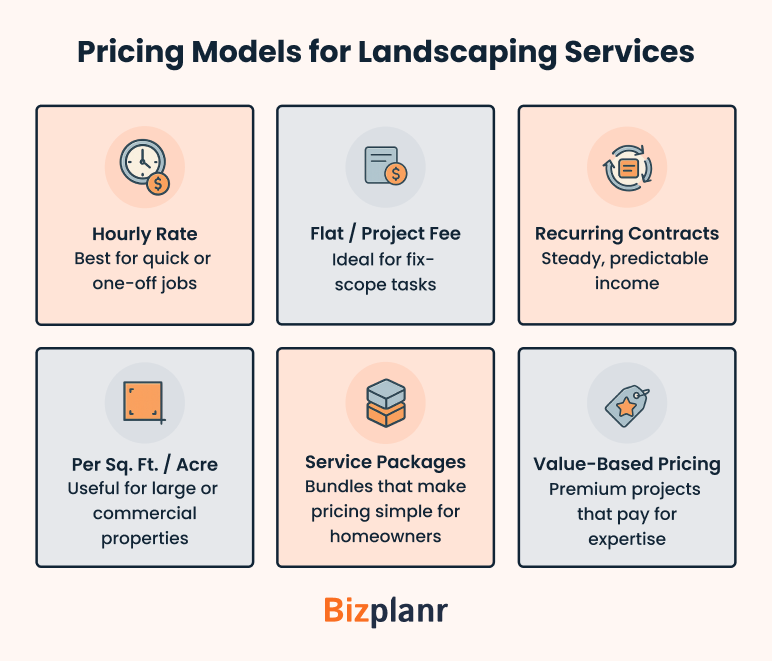I’ve watched dozens of people try to “start a landscaping business.” Most of them have the same spark: They love working outdoors, want independence, and think it’s a simple way to make good money.
But some make it big. Others burn out fast.
Why? What’s the difference?
And here’s where things fall apart:
- Where do I even start?
- What equipment do I really need?
- How do I get clients who actually pay well?
If that sounds familiar, don’t worry. Starting a landscaping business isn’t complicated once you break it down.
In this guide, I’ll show you exactly how to start a landscaping business step by step—how to plan, price, market, and grow without wasting time or money guessing what works.
Key Takeaways
- Opening a landscaping company typically ranges from $10,000 to $70,000, depending on equipment, staff size, and services.
- Specialize in a specific niche, such as residential lawn maintenance, commercial upkeep, or design, to get consistent clients.
- Writing a simple landscaping business plan helps stay organized, avoid early mistakes, and scale easily.
- Choose your market wisely. Residential jobs bring more upsell potential while commercial work offers a steady, fixed income.
- Providing seasonal services such as snow plowing or leaf cleanup maintains revenue rolling in during off months.
Step 1: Define your services and niche
I’ve met many new landscapers who have trouble defining their services and niche early on. Having a clear idea of what you want to do, such as residential lawn care, commercial maintenance, or design work, makes everything easier in the long run.
This will help you determine the equipment you buy, the customers you get, and even your ability to earn. So, before you begin anything, ask yourself:
👉 Do I want to be the go-to lawn guy who keeps yards neat week after week?
👉 Do I want to create and construct one-of-a-kind patios and gardens that individuals brag about at soirees?
👉 Or maybe I want commercial contracts that pay steady money every month?
Each answer leads to a different model. Here are service types you can combine or start with:
Homeowners hiring you for lawn care think differently from property managers paying for multi-acre maintenance. Both differ from eco-friendly clients who want native plants and low-water landscapes.
If you consider “everything” from day one, you’ll burn capital and confuse customers. So, pick your niche early as it shapes your branding, pricing, and marketing for years ahead.
Bryan Clayton, founder of GreenPal, started his career the same way—by choosing a clear focus. Previously, he built a landscaping company named Peachtree Inc., specializing in reliable residential and commercial maintenance in Tennessee. He scaled Peachtree to over $10 million in annual revenue before selling it.
Using that single-service focus and insights, he launched GreenPal, now an online marketplace connecting homeowners to local lawn-care professionals across the U.S.
Step 2: Write your business plan
I’m saying this from my own experience: Skipping the plan is one of the biggest reasons small landscaping startups waste money. A clear landscaping business plan isn’t just paperwork. It’s your roadmap, saving you from trial-and-error mistakes.
Here are the key aspects to cover in your business plan:
- Your preferred niche and services
- Market research along with the target customers
- Competition and what they charge
- Startup costs
- Your operation schedules, crews, and workflow
- Marketing tactics
- Financial projections & funding
I once helped a friend launch his landscaping company in Ohio. Before buying a single mower, he drafted a simple one-page business plan. That single page prevented a dozen costly guesses about pricing and fuel costs later.
Even if you’re not seeking funds or looking for investors, take the time to write your plan. It’s the difference between running your business with confidence and running it on guesswork.
Want to create a plan that works for your business?
Use Bizplanr AI to build a solid plan in minutes!
Step 3: Calculate the startup costs
Most new landscapers toss out a random guess like “I’ll need $5K to get started.” But without a clear breakdown, that’s just optimism. Landscaping has both upfront investments and ongoing expenses, like tools, licenses, marketing, fuel, and payroll if you add help.
Here, I must say, break your costs into two parts: What it takes to start, and what it takes to keep things running each month.
If you’re starting solo and already have a truck, you can usually get off the ground with $10,000–$15,000. But a small crew with commercial-grade gear and vehicles might need $40,000–$65,000 to launch properly.
Estimated startup cost:
| Expense Category | Solo Operator (Lean Setup) | Small Crew (2-3 Workers + Truck) |
|---|---|---|
| Business Registration & Legal | $350 | $600 |
| Mowers, Trimmers & Blowers | $5,000 | $18,000 |
| Truck / Trailer Purchase or Lease | $0 – use personal vehicle | $18,000 |
| Branding & Website | $800 | $2,500 |
| Initial Marketing (Materials & Ads) | $750 | $3,000 |
| Licenses & Permits | $300 | $800 |
| Insurance (annual premium) | $1,800 | $4,200 |
| Safety Gear & Uniforms | $400 | $900 |
| Training / Certifications | $400 | $1,000 |
| Office / Admin Setup | $600 (home office) | $2,000 |
| Approx. Startup Total | ≈ $10,000 – $15,000 | ≈ $40,000 – $65,000 |
Monthly operating costs:
| Category | Solo Operator | Small Crew |
|---|---|---|
| Fuel & Vehicle Expenses | $500 | $1,200 |
| Equipment Maintenance & Repairs | $120 | $350 |
| Employee Wages + Taxes | – | $7,500 |
| Marketing & Advertising | $200 | $600 |
| Insurance (P / M Average) | $150 | $350 |
| Supplies (Fertilizer, Repairs, Uniforms) | $150 | $500 |
| Utilities & Admin | $100 | $250 |
| Approx. Monthly Total | ≈ $1,200 – $1,700 | ≈ $9,500 – $11,000 |
What matters most is your cash buffer. Landscaping income changes with seasons and weather, so plan for the slow months.
To stay safe, keep two to three months of expenses in reserve. If your solo setup costs $1,500 a month to run, keep at least $3,000–$4,500 saved. If you’re managing a team that costs $10,000 monthly, aim for $20,000–$30,000 in reserves.
Those funds are your safety net. They’ll keep your business running smoothly while you build repeat contracts and stable cash flow.
Step 4: Register your business and get licenses
After figuring out your startup costs, the next big step is to make your landscaping business “official”. It protects you legally and builds client trust as they choose professionals over amateurs.
First, choose a legal business structure. This usually includes:
- Sole proprietorship: Simplest if you’re solo.
- LLC: Best mix of protection and flexibility.
- Corporation: Useful when scaling with multiple crews or investors.
👉 For most landscapers, an LLC strikes the right balance as it protects your personal assets from business lawsuits.
Next, register your company name and get your business license from the local office. Requirements vary by state, county, and city.
Based on the service type, the common licenses needed are:
| Service | License/Permit Required |
|---|---|
| Large projects/hardscaping | Contractor's License |
| Applying pesticides/fertilizers | Pesticide Applicator License |
| Installing irrigation systems | Water/Irrigation Permit |
| Hauling debris | Waste Disposal Permit |
If you’re working from home, you might need a home occupation permit. Also, get an EIN (Employer Identification Number) and sales tax permit from the Internal Revenue Service (IRS).
Lastly, don’t forget to secure insurance before your first job. One uninsured accident ends your business. And that’s why insurance isn't optional.
The below is an essential coverage breakdown:
- General Liability Insurance for property damage, injuries to clients
- Commercial Auto Insurance for vehicle accidents while working
- Workers' Compensation Insurance for employee injuries (required if you hire)
- Equipment Insurance for theft or damage to your tools
Step 5: Buy the right equipment and tools
I get that equipment is the biggest startup expense. So, buy smart, not cheap. They’re what keep jobs on schedule and clients happy.
In the beginning, you don’t need every gadget on the market. Start lean, invest in durable, commercial-grade essentials, and upgrade as your workload grows.
Focus on what helps you earn money immediately. A solid mower and trimmer matter more than a flashy truck wrap or expensive uniforms. Here’s what a practical starter setup looks like:
| Equipment | Purpose | Typical Cost (USD) |
|---|---|---|
| Commercial lawn mower (push or zero-turn) | Core mowing work; handles heavy daily use | $2,000 - $9,000 |
| String trimmer & edger | Trimming around fences, sidewalks, and beds | $250 - $600 |
| Leaf blower (handheld or backpack) | Clearing clippings, leaves, and debris | $200 - $500 |
| Hand tools (rakes, shovels, pruners, wheelbarrow) | General yard work, soil movement, and cleanup | $350 - $700 |
| Safety gear (gloves, goggles, boots, ear protection) | Crew protection and compliance | $200 - $500 |
| Trailer or truck rack setup | Transporting mowers and tools to job sites | $3,000 - $8,000 |
Here’s the truth: Reliability matters the most. One broken mower in the middle of summer can cost you an entire week of work and a few unhappy clients. Thus, it’s smarter to have one dependable mower and trimmer than a garage full of tools collecting dust.
As your client base grows, expand gradually, add:
- Hedge trimmers
- Aerators
- Fertilizer spreaders
- Snow-removal attachments
When funds are tight, leasing or buying used commercial gear is a smart move—as long as you’ll need to check service records and engine hours. A well-maintained used mower will outperform a cheap new one every time.
Step 6: Set your pricing model
I often tell new business owners that pricing isn’t just about numbers. It’s about how you communicate your value.
The way you price your service says a lot about your confidence. If your rates are too low, people might question your quality. If they’re too high without a reason, they’ll look somewhere else.
Your goal is to find that middle ground—pricing that feels fair, covers your costs, and matches the value you deliver. As you take on more projects, you’ll get a better feel for what works for your type of clients and jobs.
Let’s look at the most common pricing options:
If you’re just starting out, keep it simple. Go with hourly or flat rates. It’s easier to manage and helps you understand what your time and effort are really worth.
Once you’ve built experience and a few long-term clients, shift toward contracts or packages for a predictable monthly income.
I’ve seen too many small landscaping owners burn out because they priced work just to “get the job.” Eventually, that leads to exhaustion and no profit. But when they treated pricing strategy as a reflection of value, everything changed. Clients trust clear, confident pricing.
Step 7: Build your brand and market your services
You can mow like a pro, but if no one knows you exist, you'll remain invisible. Branding is not merely having a logo or nice graphics; it's the way folks remember you and what they talk about when you're not in the room.
Start with the basics: A clean logo, consistent colors, matching uniforms, and a simple tagline that communicates your value. Something as short as “Keeping Franklin green, one yard at a time” can make you sound both local and professional.
I always tell new entrepreneurs that branding doesn't have to be complicated. It merely needs to be clear and consistent. See and examine what big businesses do.
For example, take inspiration from national brands like TruGreen. Their website headline says: “Get a golf-course-quality lawn for as little as $1 a day.”
This line works because it answers three client questions at once:
👉 What will I get in return?
👉 How much will it cost me?
👉 Why should I believe you?
Now, you can use that same strategy for your own business. Talk directly to what customers want—a clean, dependable, hassle-free yard—and make it simple for them to say yes.
Once your message is good to go, put it in front of people. Start small but be consistent:
- Complete your Google Business Profile.
- Post before-and-after pictures of your work on social media.
- Request referrals and brief testimonials from satisfied customers.
- Distribute flyers, brochures, or banners.
- Place yard signs after every finished job (with permission).
- Build connections with realtors & property managers.
When your message is crystal clear, genuine, and consistent, your work does the talking. This will let your name consistently appear in local searches as well as neighborhoods, and trust builds naturally.
Step 8: Hire and manage staff (optional at start)
Most landscapers start solo. Mowing, trimming, and handling clients are all done by themselves. Well, that’s the best way to learn the trade.
But once you start booking recurring work that fills about 40–50 hours a week, it’s time to think about hiring your first full-time employee.
Don’t wait until you’re overwhelmed to look for help. Hire a little before you’re drowning in work, not after. And don’t rush into adding another big project or install until your first crew is trained and working smoothly.
I’ve seen too many new business owners hire too fast. Later on, they realized they didn’t have steady work or a system to manage everyone.
Hence, I share with you a few points to keep in mind while you start hiring:
- Start small with one or two reliable people. You can grow your team once work stays steady.
- Avoid hiring friends or family. It’s hard to keep things professional when personal ties are involved.
- Train your team. Show them exactly how you want lawns mowed, tools used, and clients treated.
- Be clear about wages, work hours, and responsibilities upfront.
- Plan for extra costs, like payroll taxes, insurance, and workers’ compensation.
- Divide the work. One mows, another trims and cleans up, while you handle clients.
- Set the example. Be on time, stay professional, and your team will follow your lead.
And yes, your employees represent your business. If they do good work and treat clients well, your reputation grows fast. But if they rush through jobs or show up late, your name takes the hit.
I know hiring feels like a big step. But it's also how you grow beyond working 60-hour weeks forever. Get the right person, train them well, and you'll take on more work without sacrificing quality.
Get an investor-ready plan in minutes!
Answer a few basic business-related questions, and AI will create a detailed plan.
Step 9: Streamline operations before scaling
Running jobs back-to-back without a proper system can quickly become chaos. I can tell you missed appointments, broken tools, and confused schedules can hurt your reputation faster than anything else.
That’s where strong, well-managed operations keep everything steady—your schedule, your team, your equipment, and your customer relationships.
Over the years, I’ve noticed a few small landscaping companies grow faster. Not because they worked harder, but because they got organized earlier.
If you build simple routines for the everyday tasks, your business operates like clockwork and sounds more professional. This will make your clients happier and your team more productive.
The following are some of the major areas to concentrate on:
| Area | Why It Matters | How to Manage It |
|---|---|---|
| Scheduling | Avoids double-booking and wasted travel time | Use a calendar or route-planning app to organize daily jobs |
| Equipment Care | Prevents costly breakdowns | Set regular service days for mowers, trimmers, and vehicles |
| Client Communication | Builds trust and repeat business | Send reminders, updates, and thank-you messages after jobs |
| Expense Tracking | Keeps finances clear and tax-ready | Record fuel, supplies, and payments weekly — not at year-end |
| Quality Checks | Protects your reputation | Inspect work regularly or ask clients for quick feedback |
Once these systems become part of your routine, scaling your business gets much easier. Adding new clients or even an extra crew won’t mean extra stress. You’ll just be expanding a process that already works.
Efficient operations save time, reduce stress, and help you grow. When your business runs smoothly behind the scenes, clients notice that and trust you more, refer you more, and keep coming back season after season.
Step 10: Launch your landscaping business
You've worked out your startup costs, set your prices, and got your tools lined up. Now it's time to get out there. Don't sit around waiting for everything to feel perfect. Start taking jobs close to home, take pictures of what you do, and ask those first clients for reviews.
In the beginning weeks, put real effort into each job. Doing things well beats doing things fast. Three nicely finished lawns will get you more phone calls than ten sloppy ones. Every single job is your shot at making a good impression and getting people to trust you.
As you book work, keep track of what you spend and what you make. Write down how long each job takes. This information shows you pretty quickly what's making you money and what's draining it.
After a month or so, sit down and honestly look at how things are going.
- What's bringing customers to you?
- Which areas are responding best?
- Which services pay you the most?
- Where are you losing time?
Based on those answers, adjust your plan and fix what’s slowing you down.
I've talked to plenty of people who kept waiting to launch because they wanted everything lined up just right. Here's the thing—you'll learn way more from one month of real jobs than from endlessly planning.
What matters is showing up, doing good work, and figuring things out along the way. Start small, stick with it, and get better each time. That's the real way landscaping businesses grow.
5 Mistakes to avoid while starting a landscaping business
After helping and speaking with many new landscaping business owners, I’ve seen the same early mistakes come up again and again. They may seem minor at first, but they can quietly drain your time, money, and motivation.
Here’s what to watch for and how to handle them:
1. Skipping licenses and insurance
I’ve met quite a few new landscapers who skip the legal paperwork at first to save time or money. But one minor accident or client dispute can cost you far more than a license or insurance ever would.
Fix: Check your city and state legal requirements before you start. Make sure you’re properly licensed and have basic liability insurance. It’s a small step that gives you credibility and peace of mind.
2. Not defining your niche
A lot of beginners try to take on every job that comes their way. Be it lawn care, garden design, hardscaping, or irrigation. But this usually leads to exhaustion and makes it hard to deliver quality work consistently.
Fix: Focus on what you do best and build around it. Start with one or two core services you can deliver really well and expand once you have a steady client base and smooth workflow.
3. Underpricing your services
This is one of the most common traps I’ve seen. It’s easy to charge low prices to win early clients. But it usually attracts demanding customers and leaves little room for profit. You’ll end up working harder for less.
Fix: Price your work based on the time, effort, and value you bring. Not just to win a deal. Research average local rates and build a small buffer for expenses like maintenance or fuel fluctuations.
4. Buying flashy trucks & low-quality tools
I know a lot of new landscapers spend big on a fancy truck to look professional. Then buy the cheap, homeowner-grade tools they can find. But the problem is: Low-quality tools can't handle daily, multi-yard use. They break fast and slow you down.
Fix: Spend your money on commercial-grade equipment and maintain it regularly. This will keep you working, save time, and make you more money in the long run.
5. Ignoring the slow season
It’s easy to assume work will keep rolling in year-round. But landscaping slows down in winter and rainy seasons. One owner I spoke with told me his biggest stress wasn’t lack of work; it was not planning ahead for it.
Fix: Plan for slow periods early. Offer off-season services like snow removal, gutter cleaning, or leaf pickup. This keeps cash flowing all year.
Is starting a landscaping business in 2025 still worth it?
Yeah, starting a landscaping business in 2025 is still worth it if you like working outside and want to run your own thing.
People are spending more on their yards right now. Homeowners want their places to look good, and businesses need someone to keep their grounds maintained. They're happy to pay for decent work.
The industry keeps growing. IBISWorld says the U.S. landscaping market is over $170 billion and still climbing. There's space for new people who do solid work and show up on time.
You don't need something huge to make money. A small local business can work. The stuff available now - apps for scheduling, ways to market online, better equipment - makes everything easier to handle.
Get a basic plan together, buy dependable equipment, and do quality work. Put in the hours, and 2025 could be when your landscaping work turns into steady money.
Conclusion
Let's wrap this up. Starting a landscaping business can feel overwhelming at first. You need to find customers, do the work, keep things organized, and more. But if you break it down step by step, it's manageable.
Start with a basic plan. Nothing complicated—just write down what services you'll do, your prices, your costs, and how you'll find clients. Tools like Bizplanr help keep everything in one place.
With a decent plan, consistent work, and quality service, you can build a landscaping business that grows every year.
Get an investor-ready plan in minutes!
Answer a few basic business-related questions, and AI will create a detailed plan.
Frequently Asked Questions
Do I need a license to start a landscaping business?
Not always. Basic stuff like mowing or trimming usually doesn't need one. But if you want to do irrigation, use pesticides, or build patios and walkways, check your local rules—many places require a special license or permit for that.
What are the busiest months for landscaping?
Spring and summer stay the busiest since grass grows fast and people want their yards looking nice. Fall brings cleanup jobs like raking leaves. Winter slows way down unless you add services like snow removal or trimming trees.
How can I get my first clients?
Here are some ways to land your first customers:
Tell friends, family, and neighbors you're starting a business. Post photos of your work on social media and local Facebook groups. Set up a Google Business Profile so people nearby can find you. Drop off flyers and leave business cards at local shops. Ask real estate agents and property managers if they need your services.
Is landscaping a profitable business?
Yes, it can be. Many small landscaping owners make solid money with regular lawn care customers. Adding design work or hardscaping brings in even more. Most landscaping businesses make around 10–20% profit after covering expenses.
Should I start with commercial clients or residential clients?
Depends on what you want and can handle. But when starting, go with residential clients. They're easier to get, pay faster, and help you build experience and your reputation before taking on bigger commercial work. (Learn more)






